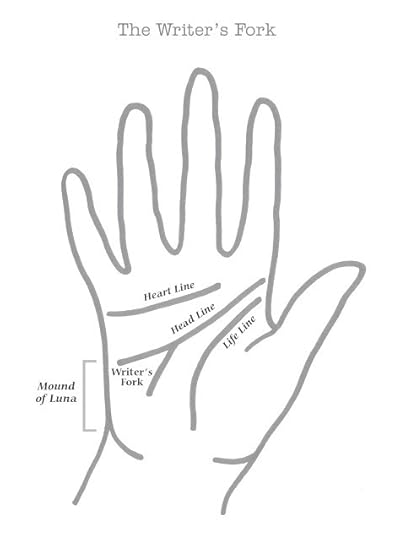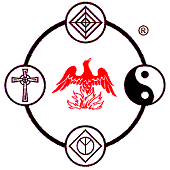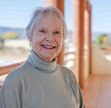Does Your Palm Reveal You Are A Writer?
 While researching Relaxing the Writer, i discovered the "Writer's Fork."
While researching Relaxing the Writer, i discovered the "Writer's Fork.""Palmistry (cheirology)proponents claim that if a palm has a tassel-like fork at the end of the HeadLine on the mount of Luna, the person possesses creative ability with words.This "Writer's Fork" shows that you are versatile, curious, and inventive.The deeper into Luna the Head Line ends, the more frequently the person willretreat into imaginary worlds. The wider the fork, the more adaptable andresourceful you are." Excerpt from Relaxing the Writer
To learn more, It's my pleasure to have have as my guest Ken A. Lagerstron, an expert on the human hand.
Ken, what is the "writer'sfork" and what does it mean?
Ken: The "writer'sfork" is where the line of head ends by splitting into two stronglines. It has been associated with natural talent in the writtenword. The longer and clearer the fork is marked on the palm, the greaterthe writing ability.
Amber: What if you have one on one hand only? (That's me - on my right hand.)Ken: Generallyspeaking, the dominant hand shows the person's actual development, while thenon-dominant hand shows latent talents and potential. A writer's fork onthe dominant hand is much more likely to indicate a professional writer.
Amber: If you lack a fork, should you stop writing?Ken: Definitely not - mostpeople's hands do not have this marking. The writer's fork is merely onesingle sign that indicates literary ability. Most people with the markingwill at least try their hand at professional writing, but since more palms donot have it, the majority of professional writers do not actually have thissign.
Amber: Are there variation in the forks a writer might find?Ken: A clear fork with only2 branches is much more likely to indicate literary ability than a tasseledending. The tassel shows more of a dissipation of energy rather thanclear use. A writer's fork with tasseled endings would typically show aregular urge to write, but that the effort is not taken to actually do thewriting.
The location of the branches of the writer's fork show what type of writing thetalent is for. A branch ending on the mount of Mars (a horizontal line ofhead) shows talent for non-fiction such as news reporting or biographies. A branch ending at the top of the mount of Luna reveals talent for fiction orsci-fi. Branches ending on the middle of the Luna mount, or lower, showthe talent is for fantasy writing. Amber: Are there other parts of the hand that indicate creativity? Ken: The mounts of Luna andApollo are typically viewed as showing creativity, as is the presence of aclear line of Apollo (Sun Line).
Some Definitions -
Cheirology- ("Cheiro"=Hand, "ology"=a science, or branch of learning)The study of all subjects dealing with the hands.
Palmistry - The art of reading the past life orfuture of a person by the lines and marks in the palm of the hand.
The Line of Head - The Line of Head reveals the basicmentality, cognitive abilities, and insanity. Abnormalities on this line showperiods of mental stress and/or brain conditions.
The Mount of Luna - Imagination, Reproduction, Fear, Sexuality.
Amber: One more question. Are the prints on aperson's palms the same on each hand or are they different?
Ken: The prints on a person's left and right palms are normally similar, but with afew distinct differences. Some people have 2 palms that are quite different inline placement (especially those with the Simian Line formation, where thelines of head and heart form one single line - http://www.humanhand.com/simian.html). The non-dominant hand can beconsidered to show the natural talents and personality traits, while thedominant hand shows where the individual makes changes to their life path (forbetter or worse).

KennethA. Lagerstrom My father has no hands, which as ayoung child I believed to be perfectly normal and natural. I was eight yearsold when the school librarian was given the arduous task of proving to me thatmy own hands wouldn't fall off one day. Her efforts began a life-long studyinto the wonders of Cheirology. Over the years the search has taken me on abizarre journey through topics with only the hands in common: Palmistry,Chirokinesics, meditation hand positions, Laying of Hands, slight-of-hand,Burning Palm, Iron Palm, reflexology.... the list goes on and on. (I used to bea member of Mensa Canada, which explains a lot.)
Ever since mydaughter was born in 2003, I've had the privilege of being a"stay-at-home-dad" while continuing my study of the hands. I takecare of all the website maintenance myself for both sites and a current memberof the InternationalSociety for Gesture Studies (ISGS).
HumanHand.com was started back in 1998, andcontinues to be one of the most viewed hand-related sites on the internet.
To learn more about palmistry,have a reading, or take a course, check out Ken's website HumanHand.com or email: ken@humanhand.com
Sign up for his newsletter or download the free ebook Laymans Guide toCheirology .
Published on November 05, 2011 01:00
No comments have been added yet.



